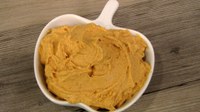Prairie Fare: Tame Your Sweet Tooth During Trick-or-treat Season
(Click an image below to view a high-resolution image that can be downloaded)
By Julie Garden-Robinson, Food and Nutrition Specialist
NDSU Extension Service
The other day, I was perusing the large Halloween section of a store. I jumped backward when a robotic zombie statue reached out and talked to me. One of the clerks chuckled at my wide-eyed reaction.
When I was a kid, Halloween was a highlight of autumn. You hoped that winter would not arrive extra early because who wanted to wear a heavy coat over a trick-or-treat costume? The main part of your costume was a plastic mask with eye holes and an elastic band to hold it in place.
All three of my kids have looked forward to the fun of dressing up and haunting the neighborhood in pursuit of sweet treats.
“Are you going trick-or-treating this year?” I asked my 13-year-old daughter the other day.
“Well, yeah,” she said as she slowly and dramatically turned to make eye contact. That’s the same reaction her older brother had at her age.
I controlled my urge to burst out laughing at the look she was casting in my direction. If you ever have had a teenager in your home, you know the look.
“I’m really short. People think I’m 8,” she added as she slumped to appear even smaller.
“OK, you might be going trick-or-treating for many years. May I go along with you?” I asked. I have been her frequent companion on her Halloween adventures.
“I’ll think about it,” she replied.
Besides wearing a costume, getting a bucket of candy is a highlight of haunting your neighborhood on Oct. 31. I don’t think this will be shocking nutrition news: Candy is not a nutrition all-star.
However, on average, people munch their way through about 3.5 pounds of candy per year. For our waistlines and overall health, we all need to practice moderation when it comes to candy.
The average American consumes 270 calories in added sugars per day. “Added sugars” are those that are not naturally present in foods.
The current U.S. Dietary Guidelines for Americans recommend limiting calories from added sugars to no more than 10 percent of our daily calories. On an average 2,000-calorie diet, that amounts to 200 calories from added sugars per day, or the equivalent of 12 teaspoons of sugar.
The American Heart Association recently set tighter guidelines for consumption of added sugars: 100 calories (6 teaspoons of sugar) for women and 150 calories (9 teaspoons of sugar) for men.
Keep in mind that many foods besides candy have added sweeteners, including ketchup, breakfast cereals and yogurt. In coming months and years, you will see new Nutrition Facts labels that advise you on the level of added sweeteners in the foods you choose.
Sugar has functions in foods. The ingredient helps preserve jellies, provides “food” for the yeast in bread, lends texture to foods and promotes browning in baked goods.
What’s a person with a sweet tooth to do? Keep moderation in mind and make some good choices so you can have your cake and eat it, too, on occasion.
If regular pop is your treat, stop at one can. That’s your added sugar for the day. Many types of sweetened beverages have 10 to 12 teaspoons of sweetener per can.
Having a healthful diet requires some “trades.” If you prefer a little candy, drink water instead of pop and have a couple of snack-sized candy bars as your treat.
Chocolate has some natural antioxidants, which may have health benefits. Double your benefits by combining chocolate with dried fruit or nuts. For a sweet treat, try some chocolate-covered raisins or peanuts.
If you dispense Halloween treats, consider some nonfood options, such as stickers, temporary tattoos, rings and other kid-friendly items. Sugar-free gum, cereal bars and 100 percent juice boxes are some healthful food options. Consider the child’s age so the food or other items do not pose a choking hazard.
After a successful trick-or-treat adventure, help your children divide their treats into smaller portions to enjoy during a period of time. Candy has a long shelf life. You can drop the candy loot in your freezer, too.
Finally, sticky sweet treats and soda pop cause cavities, so be sure the goblins in your house brush their teeth well after enjoying a little of their loot.
In honor of the icon of the Halloween season, here’s a pumpkin-flavored treat. The large carved, lighted pumpkins that greet you on doorways are a different variety than the “sugar pumpkins” typically used to make pies, breads and muffins. Using pureed, canned pumpkin will provide a smoother dessert. Canned and fresh pumpkin are excellent sources of fiber and beta-carotene, which our bodies use to make vitamin A.
One serving of this dip provides half of your daily recommendation for vitamin A, which is necessary for good skin and eye health. Serve this dip with graham crackers or crunchy apples for a seasonal treat after an evening of trick-or-treating.
Pumpkin Pie Dip
1 (8-ounce) package low-fat cream cheese (softened)
3/4 c. canned pumpkin (unsweetened)
3 Tbsp. sugar (or less, to taste)
1 tsp. pumpkin pie spice
Mix all ingredients together in a mixing bowl with a spoon or spatula. Serve with apple slices or graham crackers.
Makes 12 servings. Each serving has 60 calories, 3 grams (g) fat, 2 g protein, 6 g carbohydrate and 70 milligrams sodium.
(Julie Garden-Robinson, Ph.D., R.D., L.R.D., is a North Dakota State University Extension Service food and nutrition specialist and professor in the Department of Health, Nutrition and Exercise Sciences.)
NDSU Agriculture Communication - Oct. 20, 2016
| Source: | Julie Garden-Robinson, 701-231-7187, julie.garden-robinson@ndsu.edu |
|---|---|
| Editor: | Ellen Crawford, 701-231-5391, ellen.crawford@ndsu.edu |



